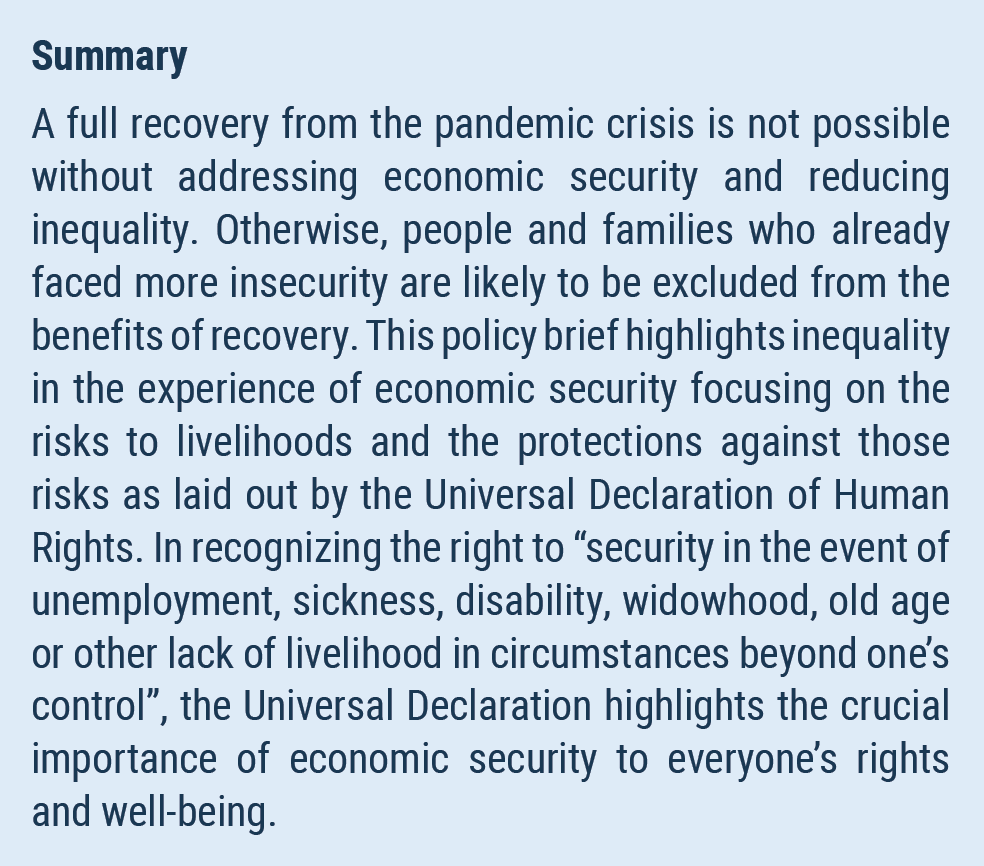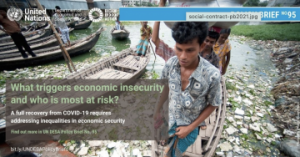 Introduction
Introduction
With the onset of the COVID-19 pandemic, many have found themselves and their families on shaky economic ground. There are significant inequalities in the degree to which different people have faced exposure, vulnerabilities and the capacity to respond to COVID-19- related shocks, due in part to substantial differences in their experience of economic risk. Such preexisting inequalities have highlighted the extent to which large-scale crises have an uneven impact on the economic security of households and individuals.
Inequalities in education, health and employment result in some groups being more economically insecure than others. Evidence from the United States and Europe, for example, shows that economic insecurity is higher among people with lower levels of education and lower incomes as well as among younger adults, racial and ethnic minorities, and heads of single-parent households (Hacker and others, 2014; Hacker, 2018). About half of large income losses from year to year are triggered by changes in employment status, family structure and health status (Hacker and Rehm, 2020).
Economic insecurity is a threat to achieving the Sustainable Development Goals and carries considerable personal and social costs. Both the experience of economic loss and its prospect impose material hardship and lead to poorer health. Economic insecurity affects people’s productivity as well as their ability to invest in their children’s education and health. At the same time, the cost to individuals and households of essential services, particularly health care, is a major cause of insecurity. Poverty breeds insecurity and widespread insecurity makes it harder to eradicate poverty and hunger. While living standards have improved across the board over the last decades, these gains are fragile, as the COVID-19 pandemic has demonstrated.
This policy brief highlights inequality in the experience of economic security focusing on the risks to livelihoods and the protections against those risks as laid out by the Universal Declaration of Human Rights. In recognizing the right to “security in the event of unemployment, sickness, disability, widowhood, old age or other lack of livelihood in circumstances beyond one’s control”, the Universal Declaration highlights the crucial importance of economic security to everyone’s rights and well-being.
Key factors underpinning economic insecurity
Unemployment and under-employment
Unemployment causes large drops in household income. In some cases, unemployment is transitory but, for many, it is a persistent risk to economic security that must often be borne individually. Unemployment protection schemes, like unemployment insurance, public employment programmes or minimum income guarantees, are not available everywhere or to everyone. Coverage of these programmes is often low, most notably for those who are self-employed, have short work histories, or are in informal employment. Globally, less than 22 per cent of unemployed persons received an unemployment cash benefit before the pandemic. The lack of assistance for the unemployed in part drives under-employment, where many are engaged in work that is less productive than they could and would like to carry out.
The labour market continues to make distinctions based on individual attributes that should have no bearing on job opportunities, including age, ethnicity and gender, affecting people’s ability to achieve economic security through work. Before the pandemic, global unemployment among young people (ages 15 to 24) was three times that of adults (ILO, 2020). Young workers are more likely than older workers to be unemployed as a result of the pandemic, risking labour market scarring that can negatively affect employment and wage prospects for the remainder of their lives. Unemployment benefits for first time job seekers are rare, and young workers frequently do not meet the minimum contributory period required to qualify for them (United Nations, 2018).
Before the pandemic, women’s unemployment rates were slightly higher than men’s globally, yet women’s disadvantage relative to men in terms of participation, formality, occupation and wages was pervasive and particularly pronounced among ethnic minority and indigenous women (ILO, 2018; United Nations, 2016). During the COVID-19 crisis, women’s paid and unpaid work has helped to maintain many households’ economic security – including through the provision of unpaid care for dependants. A large proportion of women work in the sectors most affected by the pandemic, leading to more job loss among women, who are at the same time shouldering the increased burden of childcare with the closure of schools and day care centres. Globally, more women have dropped out of the labour force than men since the crisis began. Indeed, in times of crisis, the time women spend in unpaid care work increases.
Sickness and disability
Health shocks and high out-of-pocket medical expenses are the main source of economic insecurity and reasons for falls into poverty in both developed and developing countries. When people get sick, livelihoods suffer both due to lost earnings and due to the financial costs of medical care, particularly where health insurance is lacking or insufficient. The relationship between health and socioeconomic status goes both ways. People in poorer health have lower labour force participation and wages, while those with lower education consistently report poorer health than those with higher educational attainment (OECD, 2017). Economic risk increases further when sickness leads to long-term disability.
Persons with disabilities face the dual challenge of covering higher costs of living due to their disability and, at the same time, significant obstacles to realizing their earnings potential, primarily due to physical and social barriers that hinder their access to services and employment (United Nations, 2018). It is hard to disentangle the relationship between disability and economic risk. The risk of disability increases at older ages and its onset is often a result of a process of cumulative disadvantage. For example, disability among adults of working age is both reflective of earlier socioeconomic disadvantage – childhood poverty and low educational attainment – and a source of hardship that continues into old age, in part due to reduced employment-based pensions.
Widowhood and union dissolution
Families have historically been a source of economic security, particularly in the absence of formal support from the State. At the time of the adoption of the Universal Declaration of Human Rights, the idea of a malebreadwinner model predominated; the death of an adult male meant the loss of the main source of earnings in the household.
The loss of spouse or partner, either through death, divorce or separation, continues to act as a driver of income loss and falls into poverty, particularly for women and children. Widowhood results in a substantial decline in household income and sometimes assets among women. In the event of a spouse’s death, inheritance rights for women continue to be limited in many parts of the world; 43 countries do not grant widows and widowers the same rights to inherit assets (World Bank, 2020). Women are also more likely to suffer a long-term economic loss due to divorce than men (de Vaus and others, 2015; Leopold, 2018). In the United States, differences in union stability explain some of the racial gap in wealth among older women (Addo and Lichter, 2013).
Life cycle and old age
Slightly more than two-thirds of older persons globally receive a pension, but the pension amounts are frequently insufficient to keep them out of poverty. As a result, many older persons across the world rely on their own labour, savings, or on their family, for support in old age. Yet growing insecurity in labour markets, smaller family sizes and increasing longevity are straining the traditional sources of old-age support.
Inequality compounds over the life course, and its cumulative effect is most felt in old age. Disparities in education, employment and health, including by gender, race and ethnicity, translate into inequality in the risk of economic insecurity in old age. For some workers, retirement comes with an anticipated reduction of income, one for which they have prepared for over time. However, low pension coverage and benefits puts many older adults at risk of economic insecurity. Segmented work histories, employment in less-skilled occupations or in the informal sector and lower lifetime wages for low-income workers, including women and ethnic minorities, mean lower contributory pensions and savings in old age, and higher levels of old-age poverty. In countries of the OECD, 16 per cent of women 65 and older live in poverty, compared to 10 per cent of men in the same age group. About twothirds of lifetime earnings inequality passes on to pension inequality in the OECD (OECD, 2017).
Disparities in life expectancy and health in old age also affect inequalities in economic security. Women tend to live longer than men, resulting in more expected years in old age but fewer financial resources to draw on. In general, lower levels of education and income lead to shorter lifespans. Higher mortality is paralleled by worse health in old age, with significant disparities in disabilityadjusted life years between groups in higher and lower socioeconomic status.
Policy responses to inequality in economic risk
A full recovery from the pandemic will not be possible without addressing economic security and reducing inequality. Otherwise, people and families who already faced insecurity before the crisis are likely to be excluded from the benefits of recovery. Building resilience to future shocks provides an opportunity to reduce inequality and economic insecurity.
Some groups face higher economic risk than others as well as lower protection from employers and governments when faced with unemployment, health shocks, disability, union dissolution and other forms of hardship in old age. These risks are not separate but often interrelated: a shock in one domain frequently leads to another. The answer to “who is insecure” has a dynamic dimension as people may move in and out of situations of high economic risk. There is also high degree of intersection among people who are insecure – for example, workers in the informal economy or in non-standard contractual arrangements are highly insecure; women, indigenous peoples, persons with disabilities, youth, older persons and migrants are often overrepresented in this group.
Many governments already spend a substantial percentage of GDP on social protection programmes to safeguard against hardship-causing losses due to these risks. On average across developed countries, public transfers protect about 40 per cent of adults against large (25 per cent or more) drops in income from one year to the next (Hacker, 2018). Social protection and good-quality public services also promote society-level economic security by acting both as a safety net and as automatic stabilizers, partly compensating for income reductions during crises. Countries that have social protection schemes in place are in a better position to scale them up quickly and enhance their beneficial effects during crises. Yet the effectiveness of social protection systems in smoothing incomes in the face of economic risk differs significantly across countries as well as across households. Low-income households experience higher income volatility than other groups, even after considering the effect of taxes and public transfers (Rohde, Tang and Rao, 2014; Hacker and Rehm, 2020).
Large-scale crises such as the current one heighten risk and insecurity across large swaths of society and have, at times, opened a path to expanding social protection systems. In other words, widespread insecurity has often led to higher demand for social protection. The importance of social protection is widely recognized, now. The unprecedented levels of income support and health measures put in place by governments as a response to the COVID-19 pandemic attest to the primary role that social protection plays in confronting economic risk and insecurity, and in narrowing inequalities. The challenge that remains is reaching those people who were excluded from social protection even before the pandemic. Investing in social protection systems and ensuring access for all, regardless of a person’s age, gender, race, ethnicity, disability, origin or economic, migratory or other status, reduces inequality and promotes inclusion. Now is the time to reflect on how to bring past systems of protection into the future to adapt to a new socioeconomic reality and guard against the next global crisis.
 Welcome to the United Nations
Welcome to the United Nations
